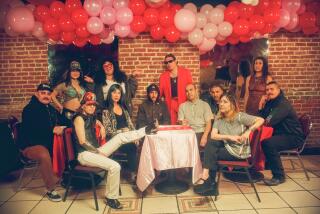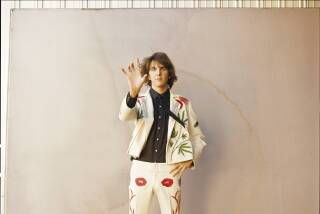The Popular Mister Parsons
David Parsons is slightly suspicious about the fact that Dance Magazine recently called him “one of an elite group of crowd-pleasing moderns.” Upon hearing the phrase repeated, he says in a flat tone, “Yeah, what’s with that?”
Parsons knows that being called “crowd-pleasing” is not always a compliment. In the modern dance lexicon, which put the word “angst” in every curve of the body, being known as popular or, even worse, “accessible,” could also mean “not quite serious enough to be art.”
But Parsons actually has been taken quite seriously by critics as well as audiences, ever since he started choreographing while still performing with the Paul Taylor Dance Company, then for the past 12 years with his own troupe, the Parsons Dance Company. It’s just that so much of his work is witty, breezy and theatrical, people tend to overlook the darker moments and rave about all the invigorating fun.
In a 1998 New York Times review, Anna Kisselgoff said that his “Ring Around the Rosie” “states his allegory about AIDS in impressively inventive terms.” But the headline was about “Instinct,” his whimsical duet with ballet sensation Vladimir Malakhov. In a phrase that could describe many Parsons dances, it said “Expressing Their Playful Inner Animal.”
Is Parsons really bothered by being called “crowd-pleasing”?
“Not really, it’s who I am,” he says on the phone at the end of what he calls “a business day” at the New York offices of his company. “I just hate being categorized--I think it takes away from the serious part of what I do. But a lot of people want to feel different things in an evening, not just the drama that modern dance is associated with, the gut wrenching. I’ve always loved entertaining people.”
His work plays well around the world--as popular in Australia, Brazil and Europe as in Normal, Ill., where one critic said, “You don’t like dance? Well, you’re bound to like something in one of Parsons’ programs.” Parsons’ signature piece, “Caught” (1982)--in which a jumping dancer is lighted only at the height of a jump thereby appearing constantly airborne--and another favorite, “Sleep Study” (1987)--a ballet of comic, restless somnambulation--established his hallmarks: clever concepts, sunny buoyancy and inventive physicality.
That tradition carries on in his latest work, “Images,” which features a version of the cinematic close-up onstage. Co-commissioned by the Irvine Barclay Theatre and private donors Susan and Howard Sosin, the 30-minute piece will have its premiere Friday at the Barclay on a mixed program that includes “Fill the Woods With Light” (in which dancers carry light sources), “Anthem” (there’s flag-waving involved) and the perennially popular “Caught.”
“Images” incorporates the photography of Howard Schatz, who spent days shooting the dance from different angles. Three-hundred-seventy of his photographs will be projected onto a 40-by-60-foot screen behind the dancers. They are programmed to “fire,” as Parsons puts it, at times that match the action onstage. What the audience will see on the screen are still images of the work, some of which zoom in on details, some of which blur and fade out, along with the live performance.
“I realized that when you watch a movie, maybe an emotional scene, it’s always done in close-ups--that’s how you get involved,” Parsons says. “And because there are these still moments where your eye can peruse the image, I think of it as a cousin of ‘Caught.’ But with ‘Images,’ there are slow moments. You might be in the back of the house, and you can see an eyeball; you can see the indentations of a touch on skin. I think you’ll get to know the dancers better.”
In workshop previews, Parsons has discovered one possible disadvantage of getting too up-close and personal: “There’s one moment when you see the dancers clothed onstage but naked in the photograph--which is really beautiful. But the problem is, nobody looks at the dancers! These are the things you learn. We’re still working on it.”
The dancers will operate in limited space--from 8 to 15 feet deep in front of the screen, depending on the theater--a limitation Parsons says he found challenging, forcing him to discover new spatial patterns. Pianist Cristina L. Valdes will play the score, a selection of excerpts from Erik Satie and Alberto Ginastera.
“Images” is more high-concept than high-tech because conventional photography and projection methods are used, but for the future Parson is looking into digital technology in order to have more control over the manipulated images. Even in an early workshop showing, though, says Carol Sosin, one of the co-commissioners, “It’s a very different view of the way you usually see dance. That’s what I like about David; he thinks of things I’ve never seen done, always very fresh. He always has a concept and works it through to the end.”
*
As eager as Parsons is to explore new territory in dance, he’s anchored to the past in one physical way--he hasn’t moved from the first apartment he had on arriving in New York as an ambitious 17-year-old with $70 in his pocket. His monthly rent was a whopping $130 back then (Parsons is now 40) and has skyrocketed to a little more than $300 today. He admits to having “a country cabin on a lake upstate” but says he rarely gets there. “You know, when I’m touring, people assume I live in a penthouse at home and have a driver,” he says. “But it’s hard for me--I didn’t have the opportunity to go to college, and you feel scared to spend money. Especially in dance, you never know what’s going to happen.”
It wasn’t a career all little boys growing up in Kansas City, Mo., dreamed of, but Parsons got started in dance because of his supportive mother, who taught preschool and put him in an arts camp after he showed an aptitude for gymnastics. At age 12, he joined a local modern dance company and a few years later started to choreograph.
“I was just taken with the freedom of expression that technique can give you,” he says. “Whipping off air turns and jumping high, feeling this very stretched body, all the shapes, the speed and control you could have. It was very exciting for a young man.”
After high school, Parsons headed for New York. No sooner had he established a routine--pumping gas all night and dancing on scholarship at the Alvin Ailey American Dance Center all day--than he got his first professional dancing job. Actually, he managed to start at the top, but only by showing up so often at the Paul Taylor dance studio and learning so much of the repertory as an understudy that he was an irresistible replacement when a dancer was injured.
Called by New York Times critic Jennifer Dunning “one of the most compelling modern dance performers of his time,” Parsons took full advantage of his nine years with Taylor by watching the way a choreographer and a dance company worked. “It was hard when I left, but it was just time,” he recalls. “I had been working in a black box theater doing my own stuff in the summer, and people kept asking me when I was starting a company. They really persuaded me to do it. I listen to things that people tell me when I meet them on the sidewalk.”
Taylor was supportive of the new dance-maker in his company, something that Parsons now tries to replicate with his dancers. His company does mainly the work of its creator (there are more than 50 original ballets in the repertory), but in the last year Parsons has begun to present new pieces by some of his 11 dancers--notably Robert Battle (who will soon strike out on his own) and Jason McDole.
“I just feel open to it as a person now,” Parsons says. “I get a real kick out of watching someone who’s good, letting them have the audience and good designers and dancers to work with. And I gain from looking at how a young choreographer works. You get so stuck in your pattern, your day-to-day thing.”
The other thing he’s stuck in, he says, is sometimes being difficult to work with: “I’m such a perfectionist, I drive my dancers crazy. I am definitely guilty of being off-the-wall irrational sometimes. I apologize, and I’m trying to change how I deal with dancers, but it’s quite difficult.”
Having stopped dancing in the last year to devote more time to choreography, Parsons is meeting with a librettist and composer in preparation for an adaptation of “The Pied Piper” for American Ballet Theatre. There seems to be room in that concept for both his playfulness and his less exposed darker side, because the merry Pied Piper not only frees a town from rats but also steals its children. For Parsons, each project is about evolution. “When I start to feel comfortable, I have to move on.”
Parsons can do no wrong for fans and supporters like Carol Sosin, a Joyce Theater board member from Connecticut. She wrote her first thousand-dollar check to the Parsons company the minute after she saw them. “I can bring a friend to a Parsons concert who’s never been to a dance event before and have them be thrilled,” she says.
But is this rampant popularity, this “crowd-pleasing,” always a good thing?
“Oh yes, I think so,” Sosin says. “It’s sort of like art--you know, everybody loves the Impressionist painters, but no one would say that they aren’t wonderful or original just because they’re popular. The Parsons company is like that.”
*
“IMAGES,” PARSONS DANCE COMPANY, Irvine Barclay Theatre, 4242 Campus Drive, Irvine. Dates: Friday and Saturday, 8 p.m. Prices: $28 and $32. Phone: (949) 854-4646 or (714) 740-2000.
More to Read
The biggest entertainment stories
Get our big stories about Hollywood, film, television, music, arts, culture and more right in your inbox as soon as they publish.
You may occasionally receive promotional content from the Los Angeles Times.










